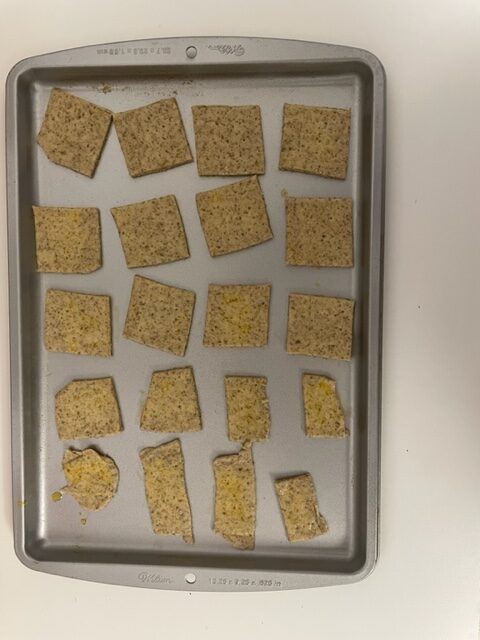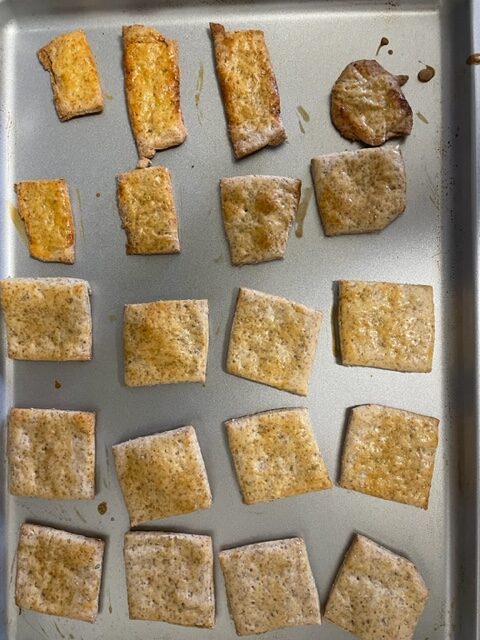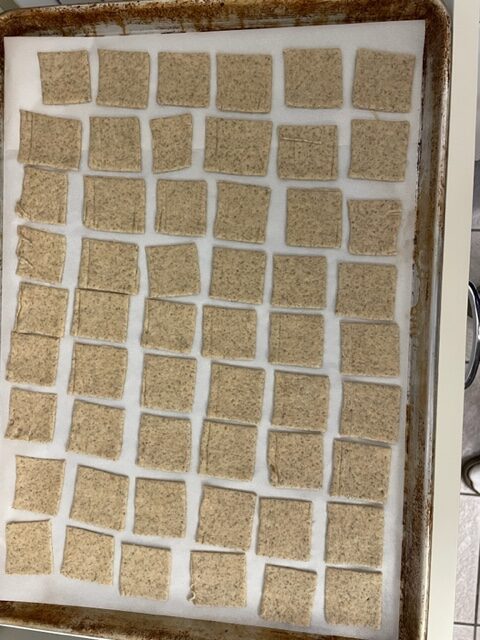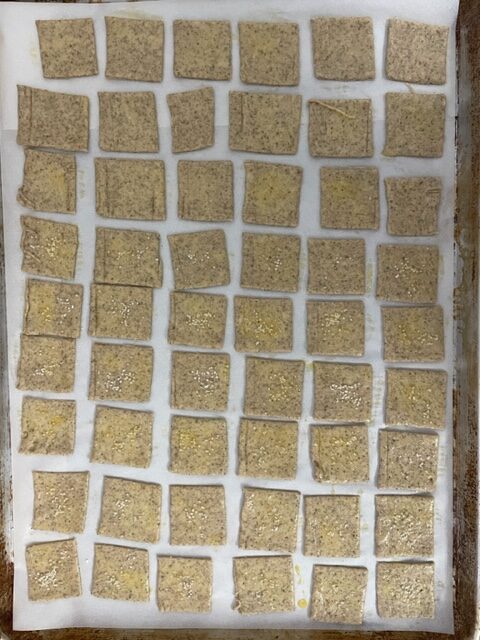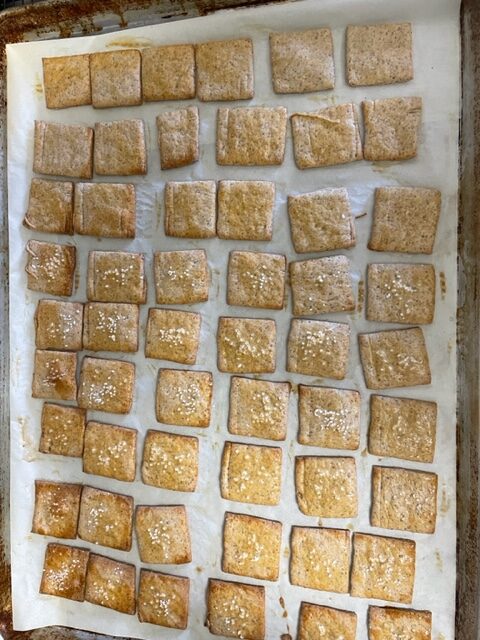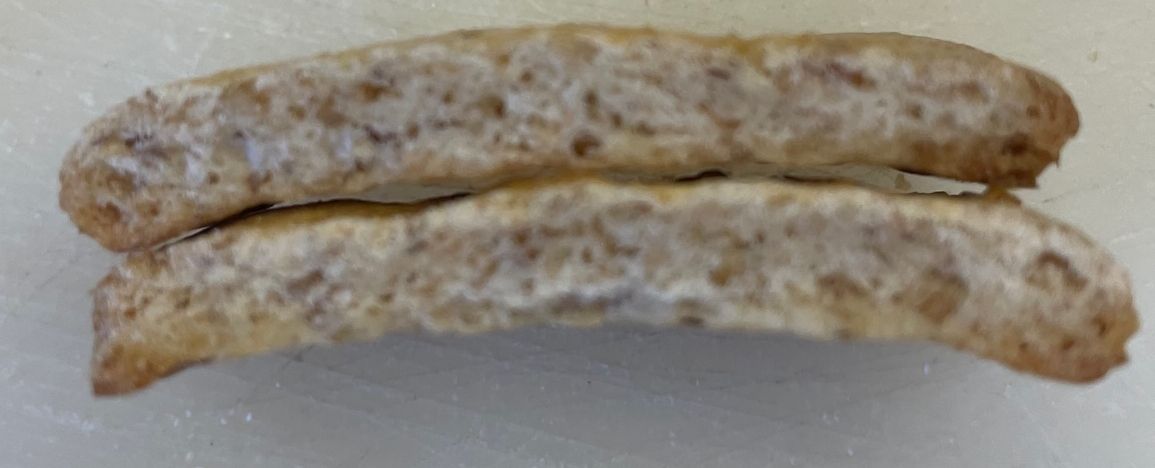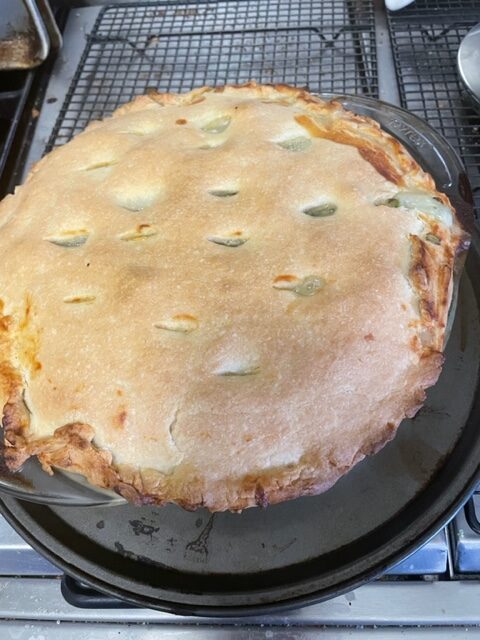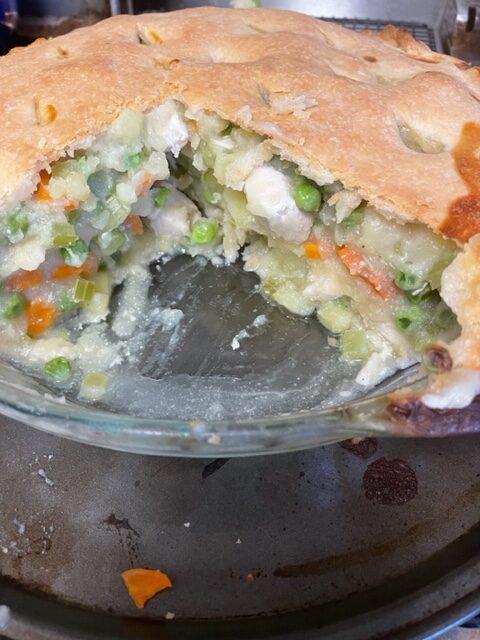Forum Replies Created
-
AuthorPosts
-
Here's the second tray (scraps rolled out a second time) before and after baking.
These are a bit thicker than the previous batch, averaging around 7.5 mm, but they sat for 20 minutes while the first batch baked, so they had some time to rise.
I don't think the docking made much difference.
Attachments:
You must be logged in to view attached files.Dough after rolling out and cutting
Dough after egg wash and salt
Crackers after baking
Edge of cracker to show thickness and crumb
Attachments:
You must be logged in to view attached files.The Brod and Taylor sheeter appears to do a very good job sheeting dough for crackers. I took them down to the '1' setting, which I think is 1mm. I'm hoping that's not too thick.
There's a '0' setting but it seems to be really thin, it'll hold a piece of parchment paper. If I need them a little thinner than the '1' setting, I could put them on one or more layers of parchment paper, I did that with one batch of laminated dough as a test, and it worked reasonably well.
The thickness of the dough seems pretty uniform, which is what a sheeter is supposed to do.
I tried a couple of ways of squaring off the dough, folding it over like you would a laminated dough seems to work OK, but you have to set the thickness setting back a few notches and work back down. Folding the edges over to produce a rectangle and pressing them down a little seems to work just about as well, and is faster because you don't have to back off on the thickness as far, if at all. I also tried just stretching the corners so they were more square before moving down to the next thickness setting. That seemed to work fairly well, too.
But it might just be easier to trim off the scraps to get a rectangle and roll the scraps back out again. That's what I did for a second smaller tray of crackers.
After they were cut, I brushed them with some egg wash. Some of them I sprinkled pretzel salt on, some I left plain, and some I left plain but docked with a fork.
It might also be possible to brush the egg yolk on before cutting them, then flip it over so you get both sides coated. (I've seen that suggested as a way of brushing pretzel crackers with a baking soda solution, though the author warns that it is a bit messy.)
I separated them on the baking sheet, I'm not sure if that's really necessary. It might be enough just to cut them and leave them in place. Worth trying, I guess.
I'll post some pictures once they're out of the oven, but they smell good so far. I used the whole wheat pretzel recipe in the KAF Whole Grains book, but substituted some coarse rye meal for about 2/3 of the whole wheat flour.
I baked them for a total of about 15 minutes at 425, but the ones in the upper left corner look a little darker, I think that's the hot spot in this oven. If I like them well enough to do another batch, I may try the convection oven setting at 400.
My digital micrometer (from a beadworking store) says they're about 6mm thick after baking, but this is a yeasted dough, so I'm not surprised. The interior seems good, not dense but not really open, either. They're a bit crisper at the edges than in the middle, that may change as they cool.
They're about 1.75 inch (45mm) squares.
If it is well-tempered chocolate, the beta-5 cocoa butter crystals melts at 92.8 degrees (33.8C), so if you get it that warm it will melt and possibly lose temper, but it may soften a bit below that.
I've been getting 11 pound bags of Callebaut callets from Stover & Company in Cheswick PA (Pittsburgh area) when we visit our son there, but they also do mail order and their shipping prices seem reasonable. Once the weather warms up they won't ship chocolate unless you pay for cool packs. I'd like to get some ruby callets from them, that's the only place I've seen the ruby chocolate at, other than the small packages of them that Trader Joe's had. Maybe we'll go out to visit our son and granddaughter this summer.
Anova makes a rectangular box designed for their sous vide machines, in two different sizes. I don't have one, yet, mainly because I'd have to figure out where to store it, but it looks like it does a good job sealing the top, which would save energy and reduce evaporation, and it is designed to hold your food under the surface of the water so it all cooks evenly.
Although I don't need it for sourdough, the Brod & Taylor sourdough home device strikes me as interesting because it can hold something at temperatures both above and below room temperature. I'm hoping they will adapt that technology to handle other types of food. There are some complex rye breads with a multi-stage starter that had fairly specific temperature for each stage.
Maybe if you took a hot knife and made score lines it'd break more cleanly? How thick is the chocolate?
When I was at Chocolate School, they were playing around with a device that cuts baked goods using high pressure water. It is designed for cutting cakes, allowing clean cuts, less waste, and even doing complex shapes, but they were testing it to cut chocolate. They had programmed it to cut a big piece of chocolate into an outline of the Chicago skyline. It was fascinating to watch.
I've seen numerous videos showing how to make tempered chocolate in a double boiler or even in a microwave.
Tempering chocolate is easier if you have something that give you good control over the temperature. Of the various methods to temper chocolate that we learned in Chocolate School, I prefer to use the seeding method:
First I heat the chocolate to 40 degrees (C) to make sure all the fat crystals are melted, then I cool it down to about 32 degrees, and add 1% shaved cocoa butter silk (cocoa butter than has been tempered.) Stir for a minute to make sure the cocoa butter silk dissolves and you'll have a pot of tempered chocolate, it's amazing to watch how quickly the seeding works. In school we did it with a large steam table pan holding several pounds of chocolate, it only took 2-3 minutes for the entire pan to reach a good temper.
I made the cocoa butter silk using my sous vide cooker, putting the cocoa butter in a sealed jar, heating it above 36 (C) to make sure the fats are all melted, then holding the temperature at around 33 degrees for 24 hours. Once you have it in that state, pour it into a container, it'll stay in that state for a year or longer.
It should be possible to use the same process to make tempered chocolate using a sous vide cooker, you just have to make sure the jar is well-sealed and you don't get water into the chocolate afterwards. I may have to try that the next time I'm doing chocolate work, it would be convenient to have tempered milk chocolate and tempered dark chocolate available at the same time.
Beta-5 is the desired fat crystal state for tempered chocolate, it is stable at room temperatures. There's actually a Beta-6 state, but it is something that chocolate won't reach unless it has been stored for a long time.
I actually saw a troop selling Girl Scout cookies at a store today, but they were out of the two flavors we like.
Tonight I made potato leek soup, with croutons made from the double crusty bread I baked.
The challenge was finding leeks, I went to three different stores before I found some, and they were almost out.
Is that because of St. Patrick's Day?
My guess is I'll wait a couple of weeks before making another chicken pot pie, unless we both decide it just sounds too good to wait.
It's hard to break up chocolate that doesn't have score lines into neat pieces. A chocolate chopper might help, it looks sort of like an ice chopper. But I generally only use mine to chop chocolate up for faster melting.
I made the Paddy's Clonmel Kitchens Double Crusty bread today, using butter instead of oil, because I think it is more like Vienna bread that way.
We finished off the chicken pot pie tonight, I think this will go on the menu again soon.
I bought a small bag of BRM semolina flour, that should get me through two batches of bread.
I prefer year-month-day because then the dates expressed as numbers (without the dashes) are in chronological order. That's why most computer databases store them that way, though they may have the option to display them in dd-mm-yyyy order or Mon dd, yyyy order.
I've been buying 5 pound bags of BRM white pastry flour (not the whole wheat one) at Natural Grocers, and have been satisfied with it.
It was a little dry in the center, but I had made extra gravy and just put some on top.
Village Inn used to have a decent chicken pot pie, but they 'simplified' their menu during the pandemic and that was one of the things they dropped, along with my wife's favorite waffle combination. So, we've stopped going there.
Some notes on the recipe, mainly for me to remember for next time. 🙂
I used a 9.25 inch deep dish glass pie pan.
I used 20 ounces of frozen boneless chicken breasts, diced and sauteed in butter
3 large potatoes (I actually used 4 but I think 3 would be better), diced
2 ribs of celery, diced
a handful of baby carrots, diced
about 8 ounces of frozen peas
1/2 medium onion, diced
2 cups of chicken stock (for the gravy)
1 recipe of hot water pastry (Susan Purdy's recipe, the version in the recipes section is scaled up by 50%), chilled for at least a half hourBoil the potatoes to desired softness, save the water to add to the gravy.
Sautee the chicken in some butter (season with salt and pepper), then remove chicken and use the liquid to sautee the onions, celery and carrots until soft.
Make a roux with 3 tablespoons of butter and an equal amount of flour, then add the chicken stock and some of the potato water. Season with salt and pepper.
35 minutes in the oven at 425.
We both had two slices of the chicken pot pie for supper tonight, it was excellent. I need to make this more often!
Today's chicken pot pie, using Susan Purdy's hot water crust recipe:
Attachments:
You must be logged in to view attached files. -
AuthorPosts
